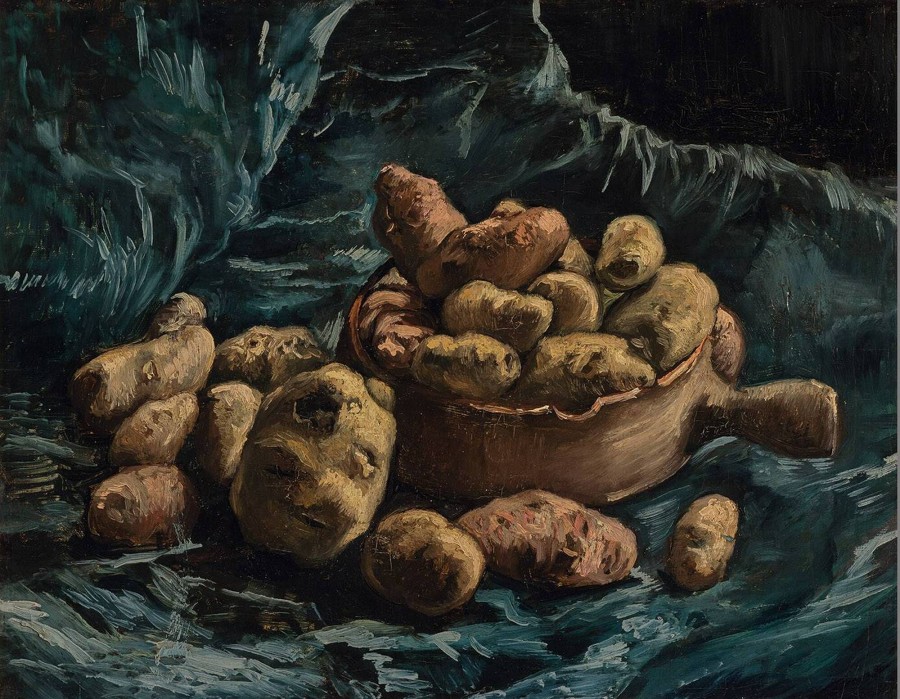Potatoes are among the most popular crops in the world. They were brought from America to Europe following the expeditions of Christopher Columbus, but they did not appear on tables until the 18th century. This was the same time that they also came to Poland, and poor peasant families played a surprisingly important role here.
by Melchior Jakubowski
Potatoes in Europe
Today, potatoes are one of the world’s basic crops: in terms of the scale of crop production, they occupy the fourth place globally, after maize, wheat and rice. Asia has experienced a real potato boom in recent decades. Currently, the largest producers of this crop are China and India, countries that until recently have not been associated with the cultivation and consumption of potatoes. Today, the Asian harvest is much larger than in other continents, including Europe. Until the early 1990s, the largest producers were the USSR and Poland. Today, Russia and Ukraine occupy third and fourth place, Poland – only eighth. Although the importance of potato cultivation in Poland has decreased, it is undoubtedly still one of its most important crops.
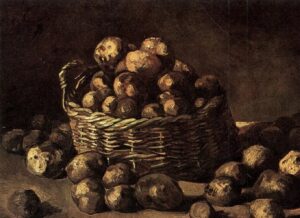
Originating from Peru, the potato reached Europe in the 16th century following the expeditions of Christopher Columbus, but it was not very popular in the beginning. Early evidence of its consumption comes from southern Spain and Ireland. It was in Ireland that the historical role of the potato was the most important. Already in the 17th century, it had become the main food of the island’s inhabitants, who would be decimated two centuries later by the potato blight (1845–1849). Potato cultivation became popular all over Europe; agricultural reformers and agronomists, trying out some novelties, imported new vegetables from the West. Like other previously unknown plants brought from the New World, the potato was first an object of observation and description (16th-17th centuries), then it gained popularity and found its place (18th century), finally, in the 19th century, it became a crop of industrial significance.
Potato cultivation significantly reduced the risk of hunger, which was a constant companion of the inhabitants of medieval and early modern Europe. Uncertain and unpredictable harvests resulted in malnutrition and diseases, including dramatic epidemics, which the famous French historian Fernand Braudel described as a “biological ancien régime”. The potato was a way out of this food trap. It was relatively easy to grow, with low climate and soil requirements, and was a very prolific plant. Like corn in southern Europe, it gained importance as a food introduced during the famine, and found a place in the daily diet later.
The potato’s role is best seen in the close relation between the expansion of the potato’s cultivation area and subsequent wars in the 17th and 18th centuries which might have resulted in famine. In uncertain times, the potato had a huge advantage; it could be kept in the ground and dug up as needed, in contrast to cereal grains harvested from the field, which could be easily stolen by an army passing through the village. A much larger European population followed from the popularization of potato cultivation. It was one of the reasons for the dynamic demographic increase in the 19th century.
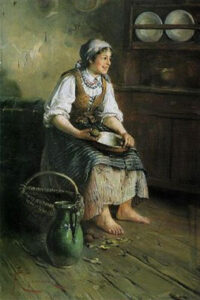
During the Enlightenment, social elites and state authorities eagerly endorsed potato cultivation. One belief from the time, widely spread in historiography, addressed the special role of rulers and outstanding individuals in making the plant popular. Frederick the Great reportedly ordered the planting of potatoes under the supervision of the army and the threat of corporal punishment for disobedient peasants, who – as traditionalists – were rather suspicious to things yet unknown to them. Similar situations occurred in France, Spain, the Habsburg countries and Russia. Meanwhile, as the research of Rebecca Earle and Rosa Congost has recently shown, Enlightenment potato propaganda came after the spread of its cultivation and resulted more from the economic beliefs of the then-elite than from any real need. The potato was seen as one of the symbols of socio-economic progress. However, peasants in Western Europe had already started planting potatoes on their own and they did not need to be persuaded to do so. The thing is – as with many other peasant activities – little evidence of this remains.
It is even more difficult to find evidence of the import and planting of the first potatoes in a given country by a specific person. Legends arose in many places; one of the most famous is the story associated with the expeditions of the English privateer Sir Francis Drake (before the Second World War, in Offenburg in Germany, there was a monument showing him with a potato flower in his hand). A little more justified is the way the French cherish the memory of the great propagator of potatoes in the time of Louis XVI, Antoine Parmentier. In Poland, to this day, King John III Sobieski (1674–1696) is remembered in this context. According to the tale, upon his return from saving the day at the siege of Vienna in 1683, John III Sobieski brought potatoes as an ornamental plant for his beloved wife, Mary. Meaning that the first potatoes in the country grew in the garden of Sobieski’s residence in Wilanów near Warsaw. This picturesque story, however, lacks any evidence, and the first testimonies of potato planting in the Polish-Lithuanian Commonwealth came half a century after Sobieski’s death.
Potatoes in the Commonwealth
An analysis of sources from the territory of the Commonwealth shows that, as in Western Europe, peasants played a key role in popularizing potato cultivation. In the 1950s, Polish historian Bohdan Baranowski estimated that potatoes were of great importance before the partitions, which happened before the enlightened absolute monarchies of Austria and Prussia (and to a lesser extent Russia) interfered in the economy. Meanwhile, in a Commonwealth deprived of modern administration, there was hardly anyone to exert any pressure on introducing a new crop; potatoes became popular thanks to migrations and contacts of the peasant population.
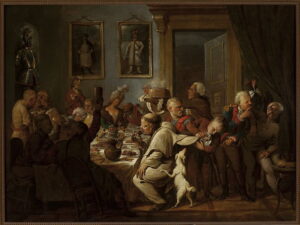
In this respect, testimony presented by Jędrzej Kitowicz (1728–1804) in his book Opis obyczajów za panowania Augusta III (Description of Customs During the Reign of August III) is very valuable: “They appeared first under King August III and were cultivated on royal lands controlled by Germans and Saxons, and for their convenience they brought this fruit from Saxony with them and multiplied it in Poland. (…) Slowly farmers on royal lands began to buy potatoes from the Germans, and from them – other farmers living on the borderlands. Finally, when potatoes were known from Żuławy near Gdańsk, from the Dutch-law settlers in Wielkopolska region and in Lithuania, when several hundred German families came to Wielkopolska (…), these foreigners, accustomed in their countries to live almost only on potatoes, helped to improve the Polish peasants mostly, and from them the nobility’s appetite, so that at the end of the reign of Augustus III potatoes were known everywhere in Poland, Lithuania and Ruthenia [today’s Ukraine].”
The opinion that potatoes were known throughout the Commonwealth at the end of the reign of August III (1733–1763) may have been somewhat exaggerated. Yet, the order in which the crop was propagated is particularly important: from royal administrators and colonists from Germany to the peasants and only at the end to the nobility.
The first description of potato cultivation in the Polish language actually comes from the end of the reign of Augustus III. In 1760, “New Economic and Scholarly News”, recognized as the first popular science journal in the Polish-Lithuanian Commonwealth, noted: “Potato is a fruit growing down in the earth.” It is worth noting at this point that in cited sources, the German word “Kartoffel” definitely dominates, and was only later surpassed by the word “potato” (already in use in the 18th century, however).
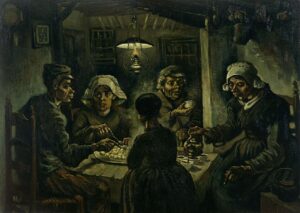
Initially, potatoes were planted mainly in vegetable gardens, which is why they are not included in the economic documentation of large-scale land estates. A rare exception is the inventory of a royal land estate with its capital in Alytus from 1786. The land estates (economies) were the administrative units of the property of the rulers of the Commonwealth, covering vast rural areas and forests. Alytus estate was located in the west of the Grand Duchy of Lithuania, on today’s borderland between Lithuania, Poland and Belarus. In the inventory from 1786, plants cultivated in gardens at individual centers of estate were included. Thanks to this, it can be said that in most cases potatoes were the most important plant in gardens, usually occupying 20-30% of the garden. In extreme case it would be as much as 55% of the garden. This means that potatoes had already played a very important role for the inhabitants of the land estate, and therefore must have been spread earlier. Kitowicz confirmed how common the new plant was, noting the important role of royal administrators in land estates. In Saxony – from which both the king and his officials came – potatoes had been cultivated since the beginning of the 18th century.
Potatoes were well received in the Alytus estate, in a region known since the 19th century as Suwałki Region (Suwalszczyzna). The oldest crop statistics, dating from the times of the Duchy of Warsaw, around 1810/11, give the share of potatoes as 4-5% of the total agricultural land area in districts with headquarters in Dąbrowa Białostocka and Sejny. These were one of the highest scores in the Duchy. To this day, the regional cuisine of the Suwałki region is based on potato.
Evidence of potato cultivation in Galicia in 1772 collected by Piotr Miodunka, also comes from the 1770s and 1780s, where new vegetables also were spread from peasants to nobility. In the Sanguszko family estate in Tarnów, potatoes in peasants’ vegetable gardens were recorded in 1786, while in the case of the “landlord’s” garden it was not until 1791.

It was only during the reign of Stanisław August Poniatowski (1764–1795) that potatoes began to be propagated in agricultural books addressed to the nobility, including in calendars. One of the first Polish naturalists, Krzysztof Kluk (1739–1796), in a book with agricultural advice from 1779, recommended planting potatoes not only in gardens, but also in fields. He emphasized that “Fallow lands are well suited for potatoes, without damaging the future winter crop.” Nine years later in his Dykcyonarz roślinny, the first Polish dictionary of plants, writing about potatoes, he noted: “Initially, they come from Peru in America, now they have been so multiplied in Europe that it is rare for us to find a farm garden where they would not be kept for use.” At that time, potatoes appeared in recipes. Baking bread from potato flour was particularly important (as a cheaper substitute for cereal flour), soon vodka began to be made from potatoes.
Potatoes every day
Examples of the grassroots potato cultivation also come from countries neighboring the Commonwealth. In Prussia, poor people were eating potatoes before the intervention of Frederick the Great. In the same period as in Galicia (60-80s of the 18th century), potatoes became popular on the other side of the Carpathian border, in what was then Upper Hungary (mainly today’s Slovakia). On the other hand, just small success was noted in the south, in Transylvania and Moldova, where a newcomer from America – corn – was a strong competition. In German countries and Hungary, as in the Commonwealth, settlers from other countries, including those running away from religious persecution, played a key role in popularizing potatoes. Migrations of ordinary people were associated with the extension of the range of the new crop.
It is worth noting that the mechanism of the spontaneous spread of potato cultivation among peasants was the same in the early capitalist West of Europe as in the feudal East. Potatoes had their first successes in peasant vegetable gardens, and therefore outside the system of nobility-focused grain production. Initially, they were a source of food for members of the poorer social classes, who were growing them close to their houses, and it was not a product intended for sale on a larger scale.

In the 19th century, potato became one of the basic plants for agriculture in Poland, cultivated on an industrial scale. It gained enormous importance as food for humans and animals. For most of the 19th and 20th centuries, it was not only an almost obligatory side dish at dinner, but also one of the basic raw materials in the production of vodka. It became widespread in all three partitions and in each region. Currently, basically every region of Poland has regional dishes prepared from potatoes. It is enough to name dishes such as Silesian dumplings or Russian dumplings or kartacze – dumplings made from grated and riced potatoes, babki – potato pastry and potato sausages in the former Grand Duchy of Lithuania (Lithuania, Belarus and north-eastern Poland). The regional nomenclature of potatoes is also very rich, like: “pyra”, “bulba”, “bulwa”, “grula” or “barabola”. To this day, the word “ziemniak” known to Poles from 18th-century sources also functions interchangeably with the word “kartofel” all over Poland. Although the importance of potatoes in Polish agriculture and cuisine has decreased in recent years, its historical role is difficult to overestimate. And nowadays it is still difficult to imagine eliminating them from our menu.
Author: Melchior Jakubowski
Translation: Alicja Rose & Jessica Sirotin

